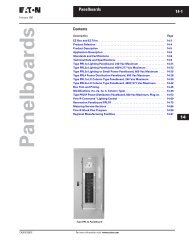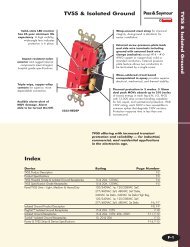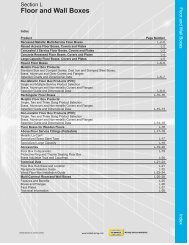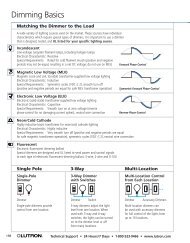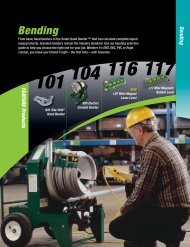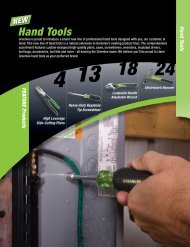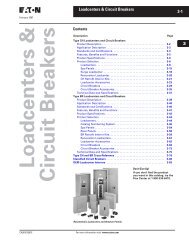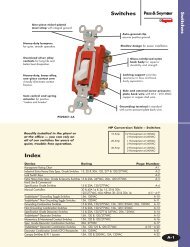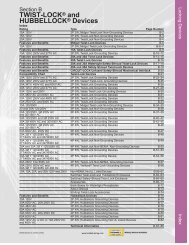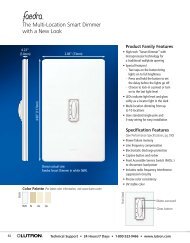Leviton Catalog - Womack Electric Supply Company
Leviton Catalog - Womack Electric Supply Company
Leviton Catalog - Womack Electric Supply Company
- No tags were found...
You also want an ePaper? Increase the reach of your titles
YUMPU automatically turns print PDFs into web optimized ePapers that Google loves.
TECHNICAL INFORMATIONNEMA and IEC Enclosure ClassificationsComparing NEMA Enclosure Type Numbers and IECEnclosure Classification Designations (IP Suitability Rating)IECIEC Publication 529, “Classification of Degrees of Protection Provided byEnclosures”, defines the IP (Ingress Protection) Suitability Rating. The IPSuitability Rating is a system for classifying the degree of protection providedby enclosures of electrical equipment. The higher the number inthe rating, the greater the degree of protection provided by the enclosure.The first numeral of the code indicates the degree of protection for personsagainst access to hazardous parts inside the enclosure and/oragainst the ingress of solid foreign objects. The second numeral indicatesthe degree of protection of equipment inside enclosures against damagefrom the ingress of water. For a more detailed explanation of the IPSuitability Code, refer to page U-12.The IP Suitability Rating defined by IEC 529 does not specify any degreeof protection against mechanical damage of equipment, risk of explosions,or conditions such as moisture (i.e. condensation), corrosivevapors, fungus, or vermin.NEMANEMA Standards Publication 250 defines the NEMA Enclosure TypeNumbers. Unlike the IEC Enclosure Classification Designations, NEMAStandards Publication 250 does tests for environmental condition suchas corrosion, rust, icing, oil and coolants. For this reason and becausethe tests and evaluations for other characteristics are not identical, theIEC Enclosure Classification Designations cannot be exactly equated withNEMA Enclosure Type Numbers.The table below provides an equivalent conversion from NEMAEnclosure Type Numbers to IEC Enclosure Classification Designations.Note that the NEMA Types meet or exceed the test requirements for theassociated IEC Classifications. Therefore, this table cannot be used toconvert from IEC Classifications to NEMA Types.Converting NEMA Type Numbers to IECClassification Designations(Note: This table cannot be used to convert IEC classification designations to NEMAtype numbers)NEMA EnclosureEquivalent IEC EnclosureType NumberClassification Designation1 IP102 IP113 IP543RIP143SIP544 and 4X IP565 IP526 and 6P IP6712 and 12K IP5213 IP54Materials Used in Wiring DevicesThe following is an overview of the materials commonly used in wiringdevices. Note that specific brand names of materials used in <strong>Leviton</strong>devices are subject to change due to a variety of factors. These changeswill never compromise the quality, performance and durability features ofour wiring devices. <strong>Leviton</strong> is committed to maintaining the positive qualitiesof the materials being replaced and choosing new materials withsuperior qualities as they become available.BrassThe type of brass commonly used in wiring devices is referred to asstandard or “70/30” brass. It is an alloy of 70% copper and 30% zincthat provides the strength and conductivity needed for power andground contacts, wiring terminals and terminal screws. It is also usedfor some mounting straps and wallplates.The Olin Corporation offers a series of alloys sometimes referred to asHigh Performance Brass or “Olin Brass.” Olin brass is a copper alloyconsisting of more than 90% copper. It is more resilient than 70/30brass and used by <strong>Leviton</strong> to form the power contacts in someIndustrial Grade and Hospital Grade devices.Phosphor BronzePhosphor Bronze, an alloy of copper and tin, is superior in strength to70/30 brass. The advantage of using phosphor bronze parts is that theycan be thinner than comparable parts made of standard brass withoutany loss in strength. For example, <strong>Leviton</strong> uses a phosphor bronze alloyof 95% copper and 5% tin to form power contacts in some IndustrialGrade receptacles. Phosphor bronze power contacts at .031" outperformbrass power contacts of a thicker gauge.Beryllium CopperAn alloy of copper and .5% beryllium is used to form some of the componentsin <strong>Leviton</strong> Industrial Grade devices. Beryllium Copper providesexcellent strength, durability, electrical conductivity. It also retains itsresiliency at elevated temperatures. These properties make BerylliumCopper ideal for the contact arm in heavy-duty switches.Silver-Cadmium OxideAlthough pure silver is an excellent conductor (superior to copper), itcannot be used for switch contacts. Over time, arcing caused byactuation would weld the silver contacts together. Silver-cadmiumoxide, an alloy of 90% silver and 10% cadmium oxide, is widely usedby <strong>Leviton</strong> to form switch contacts. Microscopic particles of cadmiumoxide in the silver will decompose due to the heat buildup, preventingthe contacts from welding together.Zinc-Plated SteelIn additon to being strong and durable, zinc-plated steel provides ahigher degree of corrosion resistance than standard cold-rolled steel.<strong>Leviton</strong> uses zinc-plated steel mounting straps in many of their devices.<strong>Leviton</strong> also offers zinc-plated steel wallplates for power receptacles,available with either a brass or aluminum finish.Nickel-Plated MetalsNickel-plating adds a high degree of corrosion resistance to either brassor steel. All the metal parts in <strong>Leviton</strong> Corrosion Resistant devices(blades, contacts, terminals, mounting straps and screws) are nickelplatedfor maximum corrosion resistance. In some cases, cupronickelscrews are used, which provide a high degree of corrosion resistance.<strong>Leviton</strong> uses an electroless nickel-plating process. The standard platingprocess uses an electrical charge to coat the metal with nickel. This canproduce uneven results, leaving some areas of the metal more coatedthan others. The more effective electroless process involves submergingthe metal in a chemical bath where salts decompose and deposit nickelon the metal substrate. Every surface of the metal is evenly coated.<strong>Leviton</strong> uses this electroless process to ensure that their CorrosionResistant wiring devices provide maximum performance in extremelydamp and corrosive environments.Stainless SteelType 430 Standard Stainless SteelType 430 stainless steel is resistant to the corrosive effects of moisture.<strong>Leviton</strong> offers a wide selection of wallplates made from this material.<strong>Leviton</strong>’s Raintight-While-In -Use Covers are supplied with stainless-steelmounting screws to help ensure a long service life in wet applications.Note that Type 430 Stainless Steel does have magnetic properties thatmay interfere with magnetic-sensitive equipment.Type 302/304 Non-Magnetic Stainless SteelType 302/304 Non-Magnetic Stainless Steel is suitable for applicationswhere sensitive equipment may be affected by magnetic material. Forexample, navigational equipment in marine applications and MRI equipmentin health care environments are susceptible to magnetic interference.In addition to being non-magnetic, Type 302/304 stainless Steel ismore corrosion resistant than Type 430 stainless steel. Types 302 and304 differ in composition, but there is virtually no difference betweenthem in terms of non-magnetic and corrosion-resistant properties.For answers to technical questions, call <strong>Leviton</strong>’s Techline at 1-800-824-3005Technical InformationV15



